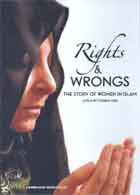
Rights and Wrongs: the Story of Women in Islam 2011
Distributed by Women Make Movies, 462 Broadway, New York, NY 10013; 212-925-0606
Produced by Mohammad Dasthi
Directed by Corinne Huq
DVD, color, 135 min.
Sr. High - General Adult
Islam, Women’s Studies, Religious Studies, Middle Eastern Studies
Date Entered: 11/06/2012
Reviewed by Barbara J. Walter, Longmont Public Library, Longmont, COIslamic feminism, which derives its understanding and mandate from the Qur’an, seeks rights and justice for women, and for men, in the totality of their existence… Islamic feminism advocates women’s rights, gender equality, and social justice using Islamic discourse as its paramount discourse, though not necessarily its only one. Margot Badran, in Al Ahram OnlineAre Islam and feminism mutually exclusive? Not so, contends Corine Huq in her illuminating critique of the status of women in Islam. Interviews with prominent journalists and authors, scholars in law and religious studies are interspersed with colorful animatics depicting the life of the prophet Mohammad, all to support Huq’s assertion that the Qur’an, with its overarching theme of justice, actually teaches the equality of men and women—and that suppression of women in Islamic society arose from faulty translation and interpretation of the holy book by men throughout the centuries.
Beginning with the “jahiliyyah,” or time of ignorance before the coming of the Prophet, Huq describes the plight of Middle Eastern women, who were little more than chattel with little control over self, children or property. The Suras (the 114 sections of the Qur’an) raised the social status and dignity of women, forbidding the practice of female infanticide, granting complete economic independence to women along with the right to own property, to participate with husbands in family decision-making, and to divorce.
However, from a very early point in time, different translations and interpretations of the Suras took hold. To illustrate, Huq reads two translations of a passage from Sura 2 which has been used by some to insist that women are inferior to men. The older translation speaks of women as being lower in degree than men; the more contemporary version emphasizes men’s higher degree of responsibility, owing to their greater strength—a very different emphasis altogether.
Polygamy, or more accurately, polygyny (one man taking several wives), child marriages, wife-beating, the veiling of women—Huq addresses each of these sensitive issues in a straightforward way, grounding the discussion in a historical and cultural context.
Her explanation of the complexities surrounding the hijab, or veil, is especially insightful: originally, the Qur’an required men to address the wives of Mohammed from behind a hijab, or curtain, to maintain propriety and to grant the women privacy in a very busy household. Sura 24 advised believing women to draw the khimar, or cover, over their bosom for modesty’s sake; Huq points out that, at the time, traditional dress for Middle Eastern women could be quite revealing. But later interpretations of these passages, and cultural perception of women as temptresses, required veiling of all women—in some places, head to foot—to ensure chaste behavior between men and women in public. Though the Qur’an instructs all believers to be modest in behavior and dress, it is women who must bear the burden daily of preventing unchaste behavior.
Huq notes that today the hijab is also a political issue—in France, Muslim women and girls are forbidden to wear the hijab in public schools, universities and government buildings, and full-face veils are banned in all public places. Conversely, in the Islamic state of Iran women and girls must cover their heads in public; those who wear their headscarves too loosely may be punished for wearing it incorrectly.
A thoughtful and informative look at the history of women in Islam, Rights and Wrongs clearly portrays feminism at work within modern Islam. While especially suited to libraries supporting college-level courses in women’s, religious and Middle Eastern studies, the film is equally appropriate for public libraries and high school media centers.